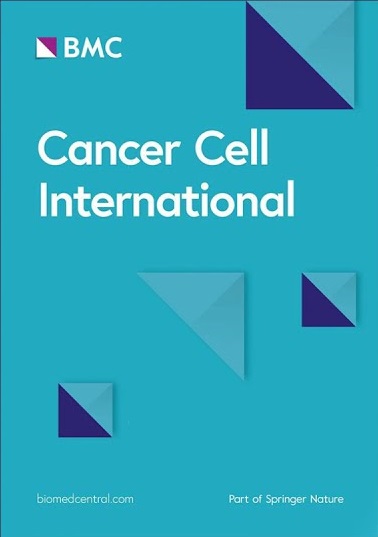KDM4A 通过下调 BMP9 导致谷氨酰胺代谢增强,从而促进乳腺癌的恶性进展
IF 5.3
2区 医学
Q1 ONCOLOGY
引用次数: 0
摘要
最近的研究发现,组蛋白修饰基因在肿瘤进展中扮演着越来越重要的角色。赖氨酸(K)特异性去甲基化酶4A(KDM4A)是一种组蛋白赖氨酸特异性去甲基化酶,在多种恶性肿瘤中高表达,数据显示,KDM4A与乳腺癌中的骨形态发生蛋白9(BMP9)呈负相关。而之前的实验表明,外源性 BMP9 能显著抑制乳腺癌的发展。我们利用实时定量 PCR(RT-qPCR)和 Western 印迹检测了 KDM4A 在乳腺癌中的表达以及 KDM4A 与 BMP9 的关系,并通过 ChIP 实验验证了 KDM4A 与 BMP9 之间的相互作用。同时,我们还利用放线菌素 D 和环己亚胺检测了 KDM4A 是否对 BMP9 的 RNA 和蛋白质稳定性有影响。通过 ELISA 检测α-酮戊二酸(α-KG)水平,观察 BMP9 对乳腺癌细胞谷氨酰胺代谢的影响。通过免疫荧光染色和 Western 印迹观察外源 BMP9 处理乳腺癌细胞后 KDM4A 的核质分布。采用裸鼠皮下异种移植肿瘤模型研究外源性BMP9和KDM4A抑制剂(JIB-04)对乳腺癌的治疗效果。实验中使用了 CCK-8、锥体形成、Transwell、伤口愈合和免疫组化等方法来监测肿瘤的生长和细胞功能。我们发现 KDM4A 在乳腺癌中异常高表达,并通过去除 BMP9 基因区域的组蛋白甲基基团沉默 BMP9 的表达。同时,KDM4A 还能降低 BMP9 蛋白的稳定性。酶联免疫吸附试验证实,BMP9 可抑制乳腺癌患者的谷氨酰胺代谢,导致其产物 α-KG 减少。免疫荧光染色和 Western 印迹证实,α-KG 减少导致 KDM4A 的核质分布改变。动物实验证实,将外源性 BMP9 和 JIB-04 结合使用对乳腺癌的治疗效果明显更好。KDM4A 通过移除 BMP9 基因区域的组蛋白甲基来沉默 BMP9 的表达,导致谷氨酰胺代谢进一步增强,从而导致恶性肿瘤的进展。此外,将 JIB-04 与外源性 BMP9 联合使用,可以更显著地抑制乳腺癌细胞的恶性进展和肿瘤的生长。本文章由计算机程序翻译,如有差异,请以英文原文为准。
KDM4A promotes malignant progression of breast cancer by down-regulating BMP9 inducing consequent enhancement of glutamine metabolism
Recent studies have found that histone-modified genes play an increasingly important role in tumor progression. Lysine(K) specific demethylase 4A (KDM4A) is a histone lysine-specific demethylase highly expressed in a variety of malignant tumors, data showed that KDM4A was negatively correlated with the Bone Morphogenetic Protein 9 (BMP9) in breast cancer. And previous experiments have demonstrated that exogenous BMP9 significantly inhibits breast cancer development. We detected the expression of KDM4A in breast cancer and the relationship between KDM4A and BMP9 using real-time quantitative PCR (RT-qPCR) and Western blot, and verified the interaction between KDM4A and BMP9 by ChIP experiments. At the same time, we also detected whether KDM4A had effects on the RNA and protein stability of BMP9 using actinomycin D and cycloheximide. Measurement of alpha-ketoglutarate (α-KG) level by ELISA to observe the effect of BMP9 on glutamine metabolism in breast cancer cells. Nucleoplasmic distribution of KDM4A after exogenous BMP9 treatment in breast cancer cells were observed by immunofluorescence staining and Western blot. A subcutaneous xenograft tumor model in nude mice was used to study the therapeutic effects of exogenous BMP9 and KDM4A inhibitor (JIB-04) in breast cancer. CCK-8, conoly formation, Transwell, wound healing, and immunohistochemistry were used to monitor the growth of tumor and cell function. We found that KDM4A was abnormally highly expressed in breast cancer, and silenced BMP9 expression by removing histone methyl groups from the BMP9 gene region. Meanwhile, KDM4A could also reduce the stability of BMP9 protein. BMP9 inhibit glutamine metabolism in breast cancer, resulting in a decrease in its product α-KG, is confirmed by ELISA. Altered nucleoplasmic distribution of KDM4A due to decreased α-KG was confirmed by immunofluorescence staining and Western blot. Animal experiments confirm that the combination of exogenous BMP9 and JIB-04 shows significantly better results in breast cancer. KDM4A silences BMP9 expression by removing histone methyl groups from the BMP9 gene region, leading to further enhancement of glutamine metabolism, which contributes to malignant tumor progression. In addition, using JIB-04 in combination with exogenous BMP9 could inhibit the malignant progression of breast cancer cells and the growth of tumors more significantly.
求助全文
通过发布文献求助,成功后即可免费获取论文全文。
去求助
来源期刊

Cancer Cell International
ONCOLOGY-
CiteScore
10.90
自引率
1.70%
发文量
360
审稿时长
1 months
期刊介绍:
Cancer Cell International publishes articles on all aspects of cancer cell biology, originating largely from, but not limited to, work using cell culture techniques.
The journal focuses on novel cancer studies reporting data from biological experiments performed on cells grown in vitro, in two- or three-dimensional systems, and/or in vivo (animal experiments). These types of experiments have provided crucial data in many fields, from cell proliferation and transformation, to epithelial-mesenchymal interaction, to apoptosis, and host immune response to tumors.
Cancer Cell International also considers articles that focus on novel technologies or novel pathways in molecular analysis and on epidemiological studies that may affect patient care, as well as articles reporting translational cancer research studies where in vitro discoveries are bridged to the clinic. As such, the journal is interested in laboratory and animal studies reporting on novel biomarkers of tumor progression and response to therapy and on their applicability to human cancers.
 求助内容:
求助内容: 应助结果提醒方式:
应助结果提醒方式:


